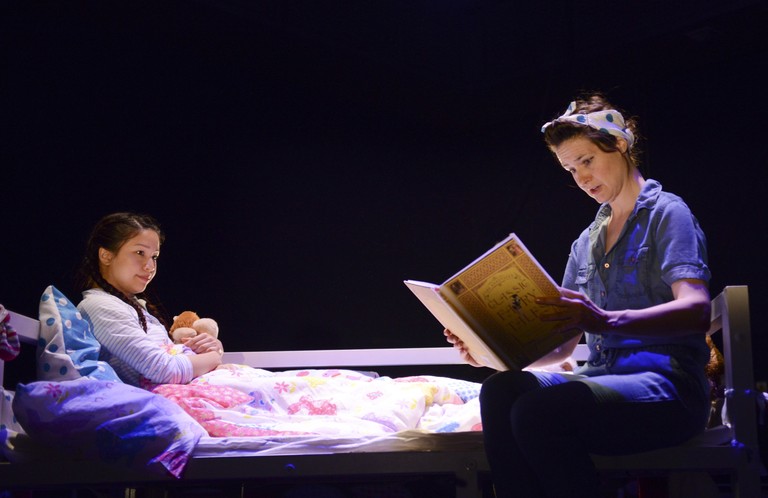The space is so inviting! A large Spiegeltent, with a bed on a platform in the middle of the circular space, a kind of giant lampshade above it. Soft night-time lighting, in gentle blues and ambers. All around the edges of the floor space, little beds and cushions. Behind them, rows of chairs covered with fluffy rugs. I feel like bagging one of the wee beds, but magnanimously give that over to two small girls, and take one of the fluffy chairs instead.
Bedtime Stories is, as far as I know, Upswing’s first children’s show (although previous work by the company, such as the delightful reimagining of Red Shoes, has often been family-friendly) – and what a pleasure it is to see a company with such sound circus / physical performance skills taking on the creation of a show for very young human beings.
Visually, it is a delight. The ‘paper lampshade’ cube is used as a four-sided screen for video and animation, which includes a very lovely cut-out shadow theatre story (of The Princess and the Nightingale). The interaction between the live performer playing the little girl on the bed and the animations is delightful. The physical work in the show is excellent – a mix of aerial silks, acrobatics, tumbling, and exuberant whizzing around on wheelie chairs. I love the way the white silks over the bed look like bedsheets, climbed up in an escape from the bed (and thus bedtime) that is both physical and metaphorical.
There is a strong narrative – seemingly simple, the story of a little girl who won’t settle down to sleep, preferring instead to romp with her imaginary friend, a boy called Three. It is made more complex by the back-story of her mother’s immensely busy life and thus stress around the bedtime story reading – the ‘mummy needs you to go to sleep’ syndrome that all parents in the audience will recognise with a sigh. Which brings us to a small problem in that show is pitched at very young children (age 2+ says the publicity!), but the narrative floats a little between age groups, and the mother’s scenes in particular are far more suitable for older children and adults. I feel it would be a stronger show if it rooted itself more firmly in one camp or the other with its storytelling. Who is the show really for? If the aim is to make a show for very young children, then the narrative needs editing back, and the show running time cut back by at least 15 minutes. If the company feel that this is the story they want to tell, then up the age guide to 6+.
Although embodied in the physical action and visual imagery, the narrative does rely quite strongly on spoken text, which is very hard to hear (at least on the occasion that I saw it, early in the run at Edinburgh’s Circus Hub). This problem may well be solved by using mics, at least for this particular venue. It is a perennial problem for circus-theatre, as few performers are equally skilled in circus skills and voicework. The male performer fares better than the two women performers in projecting his voice out to an audience in the round in a large space with a lot of background noise from both inside and outside the tent, which would be a challenge for any actor – but all three could do with more development in this area of their work.
Despite these reservations, I really enjoyed the show – it has a lovely visual aesthetic; exuberant performances from a personable, engaging and talented trio of circus artists; and it is tackling a dilemma for parents and children – the issue of so-called ‘quality time’, and the child and parent’s attitude to bedtime and separate needs – that is something worth reflecting on and discussing within a theatrical context.
The company has taken the time to create a loving and caring environment for young audiences, and recognise (as have pioneers like Theatre-Rites) that even the youngest amongst us deserve to be given performance work of quality.

